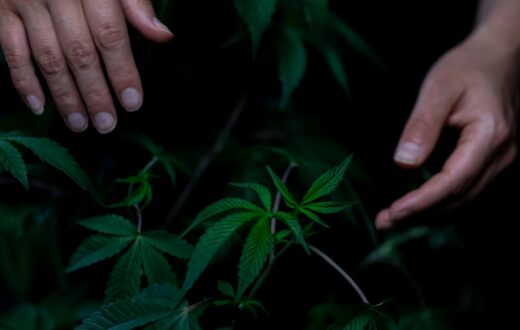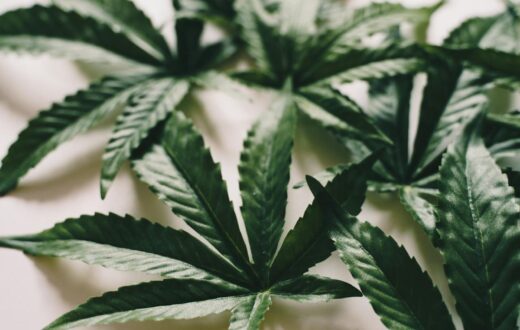Introduction to the 9lb Hammer Strain
The 9lb Hammer strain is a well-known cannabis hybrid that has gained considerable popularity among growers and enthusiasts alike. This strain is primarily made up of a potent mix of genetics from Gooberry, Hell’s OG, and Bubba Kush, leading to a balanced blend of indica and sativa effects. This genetic lineage contributes to its exceptional characteristics, making 9lb Hammer a preferred choice for both experienced and novice cultivators seeking to optimize their yields.
Originating from the Pacific Northwest, the 9lb Hammer strain has captured attention not only for its captivating aromas but also for its impressive growth traits. It typically produces dense, resinous buds that exhibit vibrant colors and a compact structure. The strain is often characterized by a sweet, fruity flavor profile that is complemented by subtle earthy undertones. These unique attributes have played a substantial role in enhancing its desirability among both recreational and medicinal users, effectively showcasing why understanding how to grow 9lb Hammer strain can be incredibly beneficial for cultivators aiming for high yield potential.
The effects of the 9lb Hammer strain are another reason it remains a favorite among users. Known for inducing a heavy, relaxing sensation, it is often utilized for its therapeutic properties, providing relief from stress, anxiety, and chronic pain. This powerful combination of characteristics—high yield potential, attractive growth traits, and distinctive effects—illustrates the importance of implementing effective growing techniques tailored specifically for this strain. In the following sections, we will delve into successful strategies and methodologies that can help maximize the growth and cultivation of the 9lb Hammer strain, ensuring growers can achieve excellent results while enjoying the cultivation process.
Understanding the Growth Cycle of 9lb Hammer
The growth cycle of the 9lb Hammer strain is integral to achieving optimal yields, making it essential for growers to understand each phase thoroughly. The cycle begins with seed germination, which typically takes 24 to 72 hours. During this initial phase, seeds require a warm, dark, and moist environment to sprout effectively. Once germination occurs, the next phase—vegetative growth—kicks in, lasting approximately 4 to 8 weeks, depending on the grower’s intention for size and yield. During this period, the plant focuses on building a robust structure, making it vital for cultivators to ensure ample light and nutrients for healthy growth.
After reaching the desired size, the plant enters the flowering phase, commencing when light cycles change to 12 hours of light and 12 hours of darkness. This critical phase usually spans 8 to 10 weeks. Effective management of the environmental conditions—temperature, humidity, and air circulation—is crucial during flowering to facilitate resin production, which is characteristic of the 9lb Hammer strain. As flowering progresses, growers should monitor trichome development to determine the ideal harvest time, ensuring the best potency and aroma.
Upon completion of the flowering period, harvesting takes place. This stage requires keen attention to detail; ideally, it is best to harvest when approximately 70-80% of the trichomes have turned cloudy, offering the best balance of psychoactive effects and flavor. Following the harvest, curing is the final phase, which is essential for enhancing flavor and potency. The buds should be dried and then placed in containers for gradual curing over several weeks. This careful approach to each growth phase minimizes risks, maximizes yield potential, and ultimately contributes to a successful experience when growing the 9lb Hammer strain.
Best Growing Conditions for 9lb Hammer
To successfully cultivate the 9lb Hammer strain, understanding the optimal growing conditions is crucial. This strain thrives in a controlled environment, ensuring maximum growth and yield through attention to several key factors, including light, temperature, humidity, and soil requirements.
Lighting plays an essential role in the development of the 9lb Hammer strain. It benefits best from high-intensity grow lights during the vegetative stage, ideally with a light spectrum that mimics natural sunlight. A 18/6 light cycle (18 hours of light, 6 hours of darkness) is recommended for vegetative growth, transitioning to a 12/12 cycle to initiate flowering. The intensity of light directly impacts the density and potency of the buds, thereby influencing overall yield.
Temperature is another critical environmental factor for 9lb Hammer cultivation. Ideally, during the daytime, temperatures should range between 70°F to 80°F (21°C to 27°C) while nighttime conditions can drop to around 60°F to 70°F (15°C to 21°C). Maintaining these temperature ranges helps prevent stress and encourages vigorous growth. It is also paramount to avoid sudden temperature fluctuations that could adversely affect plant health.
Humidity levels play a significant role throughout the growth cycle. During the seedling and vegetative stages, maintaining humidity around 60-70% fosters healthy development. However, as the plants transition into flowering, reducing humidity to 40-50% becomes essential to prevent mold and mildew infestations. This gradual decrease in humidity will further enhance the potency and flavor of the final product.
Lastly, selecting the right soil is vital for growing 9lb Hammer. A well-draining, nutrient-rich soil mix with a balanced pH around 6.0 to 7.0 ensures optimal nutrient absorption. Additives such as perlite or vermiculite can enhance aeration and drainage, creating an ideal substrate for this robust strain.
By closely monitoring these conditions, growers can create a nurturing environment that significantly boosts the growth potential of the 9lb Hammer strain.
Nutrient Requirements and Feeding Schedule
The 9lb Hammer strain is known for its high yields and robust growth, which are significantly influenced by its nutrient requirements. To promote optimal development, it is essential to understand the specific macronutrients and micronutrients that this strain requires. Macronutrients, including nitrogen (N), phosphorus (P), and potassium (K), form the foundation of its nutrient profile. Nitrogen is crucial during the vegetative phase, as it aids in leaf and stem development. Phosphorus supports root growth and flower development, while potassium regulates overall plant function, particularly during the flowering period.
In addition to these macronutrients, micronutrients play an essential role in the growth of the 9lb Hammer strain. Elements such as calcium, magnesium, and iron are vital for maintaining healthy cell structure and facilitating chlorophyll production. A deficiency in any of these nutrients can manifest as poor growth or decreased yields, making it critical to maintain a balanced nutrient regimen.
When cultivating the 9lb Hammer strain, growers can adopt either organic or synthetic feeding options based on personal preference and availability. An organic approach may include compost teas, fish emulsion, or bone meal, which not only enhance nutrient availability but also contribute to soil health. For those opting for synthetic nutrients, a balanced NPK fertilizer tailored for the growth stage can efficiently meet the strain’s requirements.
A suggested feeding schedule includes applying nutrients every two weeks during the vegetative stage, then transitioning to a flowering nutrient profile as the plants enter the blooming phase, typically around week four. This shift should consider peak nutrient needs, thereby maximizing the yield potential of the 9lb Hammer strain. Achieving a nutrient balance is pivotal in ensuring healthy growth and high yields, allowing growers to fully harness the capabilities of this remarkable cannabis variety.
Training Techniques for High Yields
Training techniques are vital for enhancing the yields of the 9lb Hammer strain. By employing various methods, growers can optimize light penetration and manage foliage, ultimately promoting plant health and productivity. Among the most effective training strategies are topping, low-stress training (LST), and the Screen of Green (ScrOG) method, each offering its unique advantages.
Topping involves cutting the main stem of the plant, which encourages lateral growth and the development of multiple colas. This method is particularly beneficial for the 9lb Hammer strain because it leads to a bushier plant structure, resulting in increased light exposure for the lower branches. With enhanced light penetration, the plant can utilize its energy more efficiently, resulting in higher yields.
Low-stress training (LST) is another effective technique that involves gently bending and tying down branches to create an even canopy. This method reduces the risk of damaging the plant while promoting better light distribution across all parts of the plant. By using LST, growers can ensure that all bud sites receive ample light, ultimately contributing to a bulkier harvest. It is important to perform LST during the vegetative stage to allow the plant ample time to adapt to its new structure.
The Screen of Green (ScrOG) technique is also worth considering for those looking to maximize their yields with the 9lb Hammer strain. This method involves using a mesh screen to support the branches while allowing them to grow through the holes created in the screen. ScrOG effectively manages the plant’s height and ensures that each cola receives a uniform amount of light. This technique not only improves yields but also cultivates a more uniform flowering canopy, enhancing the overall quality of the buds.
Incorporating these training techniques can greatly benefit growers aiming to increase their yields of the 9lb Hammer strain. By choosing the appropriate method, cultivators can ensure their plants reach their full potential while leveraging light and space effectively.
Common Pests and Diseases to Watch For
When cultivating the 9lb Hammer strain, it is essential to be vigilant about common pests and diseases that can potentially affect the health of your plants. Early identification and timely intervention can significantly safeguard your crop and ensure high yields.
One prevalent pest that growers may encounter is the spider mite. These tiny arachnids thrive in warm and dry conditions, feeding on the plant’s sap. Signs of spider mite infestation include stippling on leaves, webbing around leaf joints, and yellowing foliage. To combat spider mites, consider introducing beneficial insects such as predatory mites, or use insecticidal soap as a treatment to reduce their population.
Another significant threat to consider is the aphid. These small, soft-bodied insects can be found in clusters, usually on stems or the undersides of leaves. Aphids not only suck on sap but also excrete a sticky substance known as honeydew, which can lead to the growth of sooty mold. To manage aphid infestations, regularly inspect plants and utilize neem oil or insecticidal soap for effective control.
In addition to pests, certain diseases can also impact the 9lb Hammer strain. Powdery mildew, for example, presents as a white, powdery substance on leaves, which can inhibit photosynthesis and overall plant health. Preventative measures against powdery mildew include ensuring good air circulation and maintaining proper humidity levels. If the disease does occur, treating the affected plants with a fungicide can help manage the issue.
Furthermore, root rot, primarily caused by overwatering and poor soil drainage, can severely affect the growth of the strain. Signs of root rot include wilting leaves and a foul odor from the roots. Ensuring appropriate watering practices and using well-draining soil is vital to prevent this ailment. By being aware of these pests and diseases and implementing appropriate prevention and treatment strategies, you can cultivate a robust 9lb Hammer strain crop with excellent yields.
Harvesting the 9lb Hammer Strain
Determining the optimal time for harvesting the 9lb Hammer strain is crucial for achieving the desired potency and yield. One of the primary factors to consider is the visual cues of the plant, particularly the coloration and condition of the trichomes. Trichomes are tiny glandular structures that contain cannabinoids and terpenes, which are integral to the strain’s profile. A close examination of the trichomes with a magnifying glass or microscope will help you identify their color. When they transition from clear to milky white, this indicates peak THC levels, signifying that the plant is nearing harvest time. Conversely, if the trichomes start to turn amber, it suggests that the THC is degrading into CBN, potentially reducing potency.
In addition to trichome color, other visual cues can guide your harvesting decision. The pistils, which are the hair-like structures on the buds, will also change color as they mature. Initially, they appear bright white and progressively become darker and twisted as the buds ripen. Monitoring these indicators closely will enhance the decision-making process in harvesting the 9lb Hammer strain at its prime.
The harvesting process itself requires care and attention. It is best to harvest during the early hours of the day when the plants are at their highest moisture content. Start by cutting the branches and buds with clean, sterile scissors or pruning shears to prevent contamination. Ideally, hang the cut branches upside down in a cool, dark, and ventilated area to ensure an even drying process.
Once the buds are adequately dried, the trimming begins. Proper trimming not only enhances the visual appeal of the buds but also improves their overall flavor and potency. Using sharp scissors, carefully remove excess leaves while maintaining the integrity of the bud structure. This careful approach helps maximize the quality and yield of your 9lb Hammer strain.
Curing and Storing for Maximum Potency
The curing process is a crucial step in enhancing the flavor, potency, and longevity of the 9lb Hammer strain after harvest. Properly curing your cannabis can significantly elevate the overall experience, making it smoother and more enjoyable. This method allows excess moisture to evaporate while retaining essential cannabinoids and terpenes, which are vital for the strain’s unique characteristics.
To begin the curing process, it is essential to trim the buds effectively. After you have harvested your plants, remove large fan leaves while leaving a bit of sugar leaf to help retain moisture. Once trimmed, the buds should be placed in airtight glass jars, ensuring there is enough room for air circulation. When learning how to grow the 9lb Hammer strain, understanding the importance of the curing environment is paramount. Aim for a cool, dark place with temperatures between 60°F to 70°F and humidity levels around 62%.
During the initial days of curing, which is typically the first week, open the jars several times a day for approximately 5-10 minutes to allow fresh air in. This process, known as “burping,” helps to regulate humidity levels while fostering the development of rich flavors. After the first week, you can reduce the frequency of opening the jars to once every few days. Continue curing the 9lb Hammer buds for at least two to four weeks, although extending this period can further enhance potency and flavor.
After the curing phase, it is imperative to store the final product correctly to maintain quality. Store the cured buds in a cool, dry, and dark environment. Consider using vacuum-sealed bags or once again utilizing airtight glass jars to protect against humidity and light exposure. Following these best practices in curing and storing will ensure that your 9lb Hammer strain retains its potency, flavor, and overall quality long after harvest.
Conclusion: Final Thoughts and Tips for Success
Growing the 9lb Hammer strain can be a rewarding endeavor, provided that growers understand its unique characteristics and cultivation requirements. This strain is known for its robust growth and high yields, which can be optimized by following specific techniques tailored to its needs. Throughout the growing cycle, maintaining adequate humidity levels, providing appropriate nutrients, and ensuring sufficient light exposure are critical to achieving the desired results.
It is important to remember that the cultivation of the 9lb Hammer strain is not a one-size-fits-all approach. Each grower’s environment and conditions may differ, and adaptability is key. Experimentation with varying nutrient formulations, watering schedules, and pruning techniques might lead to better results tailored to the specific growing conditions. Keep detailed records of each phase of cultivation, as they will be invaluable for making informed adjustments in future grows.
In addition to environmental factors, recognizing the growth stages of the 9lb Hammer strain is crucial for achieving optimal yields. From germination through to harvest, ensuring that the plants receive the right care and attention during their various stages can significantly influence the final product. Utilizing training methods, such as low-stress training (LST) or high-stress training (HST), can also help shape the plant for greater light exposure and airflow, ultimately leading to a more abundant harvest.
In conclusion, successful cultivation of the 9lb Hammer strain hinges on understanding its specific needs and being willing to adapt and learn from experience. By being observant and responsive to the plants’ signals, growers can not only optimize their yields but also enhance their overall cannabis cultivation skills over time. Strive to create the best possible environment, and watch your efforts translate into a fruitful harvest.













